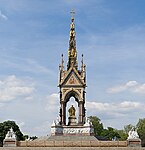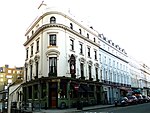Kensington Gardens
1728 establishments in Great BritainEngvarB from July 2013Grade I listed parks and gardens in LondonKensington GardensParks and open spaces in the City of Westminster ... and 2 more
Parks and open spaces in the Royal Borough of Kensington and ChelseaRoyal Parks of London

Kensington Gardens, once the private gardens of Kensington Palace, are among the Royal Parks of London. The gardens are shared by the City of Westminster and the Royal Borough of Kensington and Chelsea and sit immediately to the west of Hyde Park, in western central London. The gardens cover an area of 107 hectares (265 acres). The open spaces of Kensington Gardens, Hyde Park, Green Park, and St. James's Park together form an almost continuous "green lung" in the heart of London. Kensington Gardens are Grade I listed on the Register of Historic Parks and Gardens.
Excerpt from the Wikipedia article Kensington Gardens (License: CC BY-SA 3.0, Authors, Images).Kensington Gardens
Lancaster Walk, City of Westminster Bayswater
Geographical coordinates (GPS) Address Nearby Places Show on map
Geographical coordinates (GPS)
| Latitude | Longitude |
|---|---|
| N 51.507222222222 ° | E -0.18027777777778 ° |
Address
Lancaster Walk
Lancaster Walk
SW7 2EU City of Westminster, Bayswater
England, United Kingdom
Open on Google Maps











